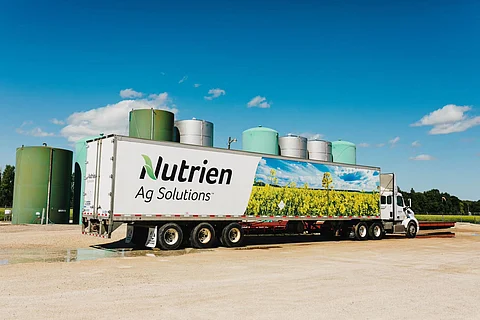

HOUSTON — Even as Prime Minister Justin Trudeau on Thursday warned of a prolonged trade war with the US, it is companies in Alberta and Saskatchewan that will bear the biggest brunt of US tariffs.
A new report from New York-based Syntax Data identifies the top 10 Canadian firms most vulnerable to revenue losses, and four of them are based in Calgary while a fifth, fertilizer giant Nutrien, is headquartered in Saskatoon.
Energy firms make up 40% of the most exposed companies, highlighting how deeply Canada’s oil and gas industry is intertwined with US markets.
According to Syntax, Calgary-based Enbridge Inc. (ranked 2nd), TC Energy (4th), Parkland Corp. (9th), and Suncor Energy (10th) are among the Canadian companies most at risk based on how much revenue is derived south of the border.
But the Canadian company most vulnerable to tariffs, according to Syntax, is Saskatoon-based Nutrien. While not an energy firm, Nutrien’s heavy reliance on US exports puts it at the top of the list of businesses at risk, it added.
On Thursday, US president Donald Trump gave Nutrien a partial break by reducing its potential hit to 10% for at least the next 30 days, but it wasn’t immediately clear if oil qualifies for the exemption.
In any event, that’s a short window for Canadian policymakers to find alternative markets for domestic products, including oil.
On Thursday, the prime minister in what is likely to be his last public appearance, said the trade war would likely last for the “foreseeable future” while vowing to fight back as long as the Liberals are in power.
“We want to continue to be strong and resolute in our response and we will continue to be there for each other because the unity that Canadians are feeling right now is actually the most important thing in being able to stand up against the trading partner that is much bigger than us,” he said, tears welling in his eyes.
But that did little to assuage the fears of Calgary firms.
Enbridge, which operates the largest pipeline system transporting Canadian crude to the US, earns 45.5% of its revenue from US operations. TC Energy is even more reliant, with 52.2% of its revenue coming from the US market — although both companies only provide the service of transporting oil, not selling it.
In a statement to The Western Standard, the company said TC Energy’s business model is largely underpinned by long-term contracts or rate regulation.
In fact, or CEO François Poirier has been trying to assure investors the impact will be minimal.
“We do not anticipate any material impact on our financial performance.”
“Our regulated Canadian natural gas pipelines business, which transports gas to be exported to the U.S. by our shippers, is protected against higher costs or loss of volumes,” he said.
Parkland and Suncor have lower relative exposure, with 20.1% and 13.1% of revenues, respectively, but it is tied to actual US sales.
“With 60% of U.S. crude oil imports coming from Canada, a 10% tariff could have major implications,” Syntax Data’s report states. “While the lower tariff suggests an effort to avoid extreme energy price hikes for American consumers, Canadian firms will still face significant revenue pressure.”
In response, Saskatchewan Premier Scott Moe announced last week that all pipeline permits for projects crossing Saskatchewan’s territory will be considered “pre-approved” — a move aimed at expediting east-west pipeline development.
“Effective immediately: All pipeline permits going east, west, or south received in Saskatchewan will be considered pre-approved,” Moe wrote on Twitter ("X"), urging other provinces and the federal government to follow suit.
Meanwhile, financial analysts say the tariffs should serve as a wake-up call for Canada’s energy strategy.
“The US tariff threat exposes how dependent Canada remains on a single export market,” RBC said in a research note. “Had past pipeline projects to the coast not been scrapped, Canada would have more flexibility in responding to this kind of trade pressure.”
Ellison Kandler, an SVP and head of equity at Syntax Data, said in an interview with BNN Bloomberg that the report looks to crystallize complex supply chain information into a simple chart.
In that sense, it’s hardly surprising that energy is identified as the most at-risk sector.
“I think that’s more of a recognition that energy, which I believe is also the biggest component of the trade deficit between the United States and Canada, is sort of an important piece that you have to be a little bit careful about.”
